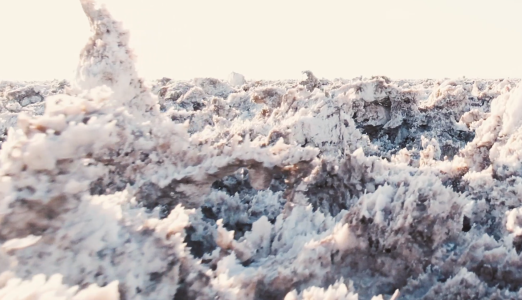New work in progress: A water-led storytelling in the driest bed of an ancient sea
This site, Atacama salt plain, once an ancient inland sea, ringed by volcanos; now one of the driest deserts in the world, where the salty crust and the underground brine waters recalls its deep-time past as a sea, rich in lithium salts.
Of the unique lithium rich-salty ground water, twice as salty as the ocean, that upwells to feed natural lagoons in the middle of the desert.
Of the complex ecosystem evolved to exist in and around these salty waters.
And at the same time, of the extraction of this water to constructed evaporation ponds, to release the water to the air and collect the lithium salts that remain, the last memories of the ancient sea.
Before Air There Was Water/ Antes del aire hubo agua
4 channel video installation, commissioned for SACO Bienal, GOLPE/ COUP Chile, June – Sept 2023. The first phase of this tenticular research.
This storytelling is about a site of watery contest; between mining and environment, where natural groundwater needed for ecological survival is increasingly extracted to scrape lithium and help humanity move to carbon-free future.
There are a series of other storytellings here unfolding across the lands that all start with water. From the small- cyanobacterial populations uniquely evolved to live in these hypersaline lagoons, above 3000m altitude, supporting a complex ecosystem- feeding brineshrimp that themselves feed animals ranging from tiny lizards through to iconic flamingos.
The cyanobacteria photosynthesise sunlight and CO2 into oxygen and energy, metabolically linked to the first cyanobacteria in that first planetary sea, before there was air; the bacterial-led great oxygenation event. The first breathers, the first eyes.
Ongoing interdisciplinary Art-Sci Research: Bacteria-water-air-ecosystems-energy policies
This is a multimodal tenticular research opening with field work to the desert, conversations with scientists, time in laboratories. Phase 1 was exhibited at SACO Bienial, Chile, June-Sept 2023
The second phase, digital twin intersections and sculptural installation, is planned for Brussels, spring 2025 as part of NaturArchy, details to follow.
With salt and rocks in our veins
(Work in progress)
Visualising a digital twin of a remote lagoon in the Atacama salare. To be intersected with a webcrawler link interruption, based on web hits for lithium, green energy and energy transition crawler hits. Collapsing the cause-and-effect distance between centers of power such as EU and peripheries, such as the Atacama desert.
Current research:
photogrametry from drone photography undertaken on fieldwork to Atacama. To build digital twins of these remote lagoons. These will be intersected / disrupted/ transformed by realtime datastreams from EU lithium led policies and daily lithium spot prices.
Current thoughts:
Cyanobacteria as the first eye: Cyanobacteria can sense and move towards light. Before air, before complex organisms such as fish, plants and animals, there were cyanobacteria. They make light havesting pigment to harvest visible and infrared light, to photosynthesise. The first eyes and the first oxygen makers.
The colorimetry of this: chlorophyl, carotenoids and phycobiliproteins; cyanobacterial trans-membrane proteins convert photons: the first eyes.
Currently recalling:
In Feb 2023, working with the Global Water team at the JRC. Locating the Sentinel satellite data from the Atacama salare, via the Global Surface Water app.
Scientific collaborators:
University of Antofagasta; Dr Benito Gómez-Silva, Biochemistry Laboratory, Biomedical Department
Dr Cristina Dorador, Department of Biotechnologia.
Joint Research Centre, EU (JRC) Global Surface Water Atlas
The making of this work was supported by the Australia Council for the Arts through a New Work grant, Stimuleringsfond Netherlands through a Starting and Project Development Grant and JRC European Commission SciArt Resonances Project IV: NaturArchy
References, links, info
http://latinamericanscience.org/2014/07/the-atacama-deserts-diamonds-in-the-rough/
Endangered Salares: micro-disasters in Northern
Chile Cristóbal Bonelli & Cristina Dorador
https://phys.org/news/2015-08-architecture-aquifers-chile-atacama.html












